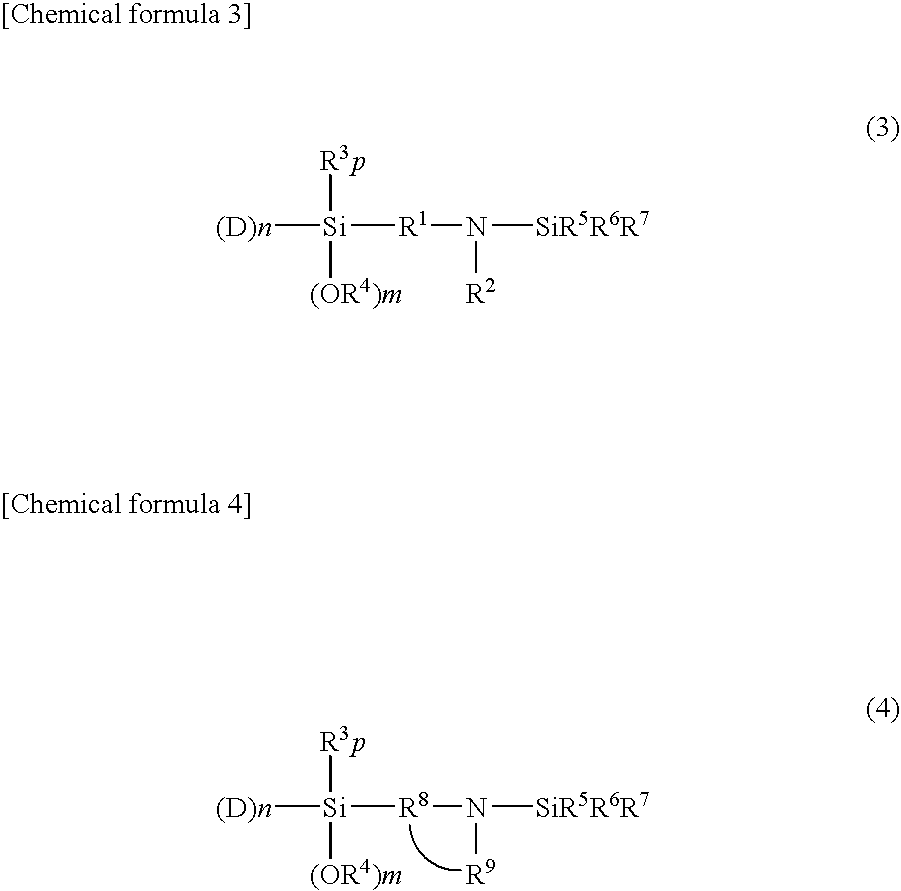Conjugated Diene Polymer and Process for Production Thereof
- Summary
- Abstract
- Description
- Claims
- Application Information
AI Technical Summary
Benefits of technology
Problems solved by technology
Method used
Image
Examples
example 1
[0125]A temperature-controllable autoclave having an internal volume of 10 liter and equipped with a stirrer and a jacket was used as a reactor and 625 g of butadiene, 225 of styrene, 5500 g of cyclohexane and as a polar substance 0.82 g of 2,2-bis(2-oxolanyl)propane from which impurities had been removed were charged in the reactor. The temperature inside of the reactor was maintained at 30° C. A cyclohexane solution containing 6.75 mmol of n-butyllithium as a polymerization initiator was fed into the reactor. After starting of the reaction, the temperature in the reactor started increasing due to heat induced by polymerization. During from 7 to 12 minutes after the addition of the polymerization initiator, 50 g of butadiene was supplied at a rate of 10 g / min. The final temperature in the reactor reached 77° C. After completion of the reaction, 13.5 mmol of N-[3-(trimethoxysilyl)-propyl]-N,N′-diethyl-N′-trimethylsilyl-ethane-1,2-diamine was added. The mixture was stirred at 75° C. ...
example 2
[0127]In a similar manner to that employed for obtaining Sample A except for the use of 3-(4-trimethylsilyl-1-piperazinyl)propyltriethoxysilane instead of N-[3-(trimethoxysilyl)-propyl]-N,N′-diethyl-N′-trimethylsilyl-ethane-1,2-diamine, a modification reaction was performed, whereby a styrene-butadiene copolymer (Sample B) was obtained. As a result of analysis of (Sample B), a bound styrene content was 25 wt. %, a bound butadiene content was 75%, and the Mooney viscosity of the polymer was 50. A 1,2-bond content of the microstructure of the butadiene moiety determined by the calculation in accordance with Hampton's method based on the measurement results using an infrared spectrophotometer was 63% and a modification ratio determined by GPC using a silica adsorption column was 85%.
example 3
[0128]In a similar manner to that employed for obtaining (Sample A), polymerization reaction was performed. A coupling reaction was then performed by adding 0.25 mmol of tetraglycidyl-1,3-bisaminomethylcyclohexane, a tetrafunctional polyepoxy compound, to the reactor and stirring the mixture at 75° C. for 2 minutes, followed by a modification reaction by adding 11.48 mmol of 3-(4-trimethylsilyl-1-piperazinyl)propyltriethoxysilane, whereby a styrene-butadiene copolymer (Sample C) was obtained. As a result of analysis of (Sample C), a bound styrene content was 25 wt. %, a bound butadiene content was 75%, and the Mooney viscosity of the polymer was 49. A 1,2-bond content of the microstructure of the butadiene moiety determined by the calculation in accordance with Hampton's method based on the measurement results using an infrared spectrophotometer was 62% and a modification ratio determined by GPC using a silica adsorption column was 83%.
PUM
| Property | Measurement | Unit |
|---|---|---|
| Temperature | aaaaa | aaaaa |
| Temperature | aaaaa | aaaaa |
| Temperature | aaaaa | aaaaa |
Abstract
Description
Claims
Application Information
 Login to View More
Login to View More - R&D
- Intellectual Property
- Life Sciences
- Materials
- Tech Scout
- Unparalleled Data Quality
- Higher Quality Content
- 60% Fewer Hallucinations
Browse by: Latest US Patents, China's latest patents, Technical Efficacy Thesaurus, Application Domain, Technology Topic, Popular Technical Reports.
© 2025 PatSnap. All rights reserved.Legal|Privacy policy|Modern Slavery Act Transparency Statement|Sitemap|About US| Contact US: help@patsnap.com



